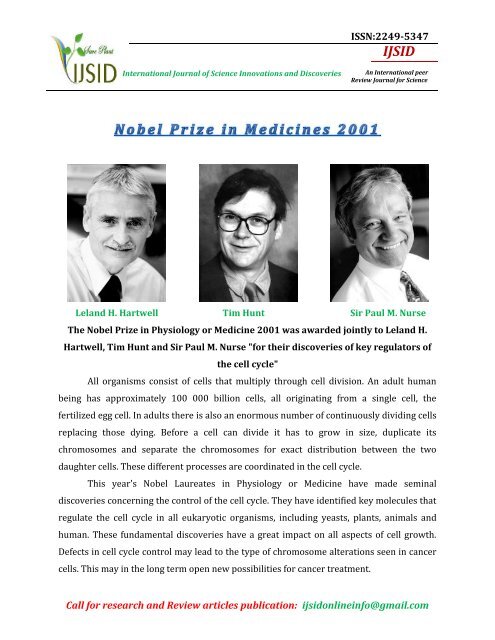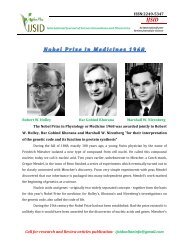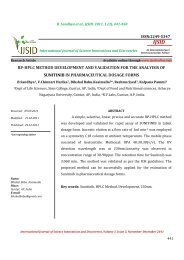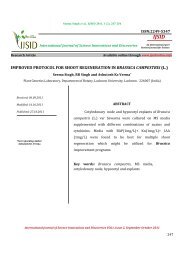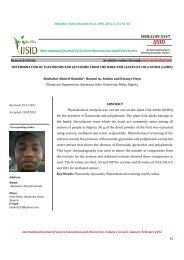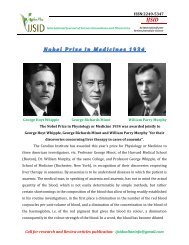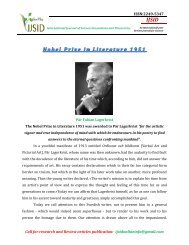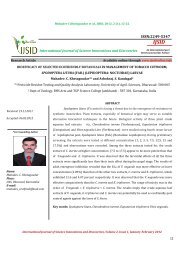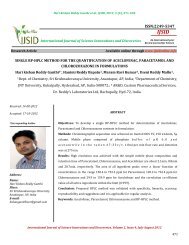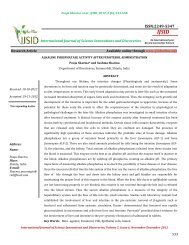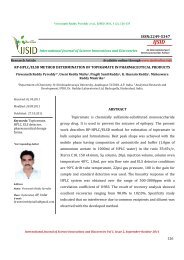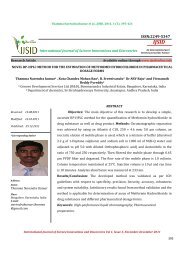The Nobel Prize in Physiology or Medicine 2001 ... - Ijsidonline.info
The Nobel Prize in Physiology or Medicine 2001 ... - Ijsidonline.info
The Nobel Prize in Physiology or Medicine 2001 ... - Ijsidonline.info
You also want an ePaper? Increase the reach of your titles
YUMPU automatically turns print PDFs into web optimized ePapers that Google loves.
ISSN:2249-5347IJSIDInternational Journal of Science Innovations and DiscoveriesAn International peerReview Journal f<strong>or</strong> Sciencewere altered (mutated). By this approach he succeeded to identify m<strong>or</strong>e than one hundredgenes specifically <strong>in</strong>volved <strong>in</strong> cell cycle control, so called CDC-genes (cell division cyclegenes). One of these genes, designated CDC28 by Hartwell, controls the first step <strong>in</strong> theprogression through the G1-phase of the cell cycle, and was theref<strong>or</strong>e also called "start".In addition, Hartwell studied the sensitivity of yeast cells to irradiation. On the basisof his f<strong>in</strong>d<strong>in</strong>gs he <strong>in</strong>troduced the concept checkpo<strong>in</strong>t, which means that the cell cycle isarrested when DNA is damaged. <strong>The</strong> purpose of this is to allow time f<strong>or</strong> DNA repair bef<strong>or</strong>ethe cell cont<strong>in</strong>ues to the next phase of the cycle. Later Hartwell extended the checkpo<strong>in</strong>tconcept to <strong>in</strong>clude also controls ensur<strong>in</strong>g a c<strong>or</strong>rect <strong>or</strong>der between the cell cycle phases.A general pr<strong>in</strong>ciplePaul Nurse followed Hartwell's approach <strong>in</strong> us<strong>in</strong>g genetic methods f<strong>or</strong> cell cyclestudies. He used a different type of yeast, Schizosaccharomyces pombe, as a model<strong>or</strong>ganism. This yeast is only distantly related to baker's yeast, s<strong>in</strong>ce they separated fromeach other dur<strong>in</strong>g evolution m<strong>or</strong>e than one billion years ago.In the middle of the 1970s, Paul Nurse discovered the gene cdc2 <strong>in</strong> S. pombe. Heshowed that this gene had a key function <strong>in</strong> the control of cell division (transition from G2to mitosis, M). Later he found that cdc2 had a m<strong>or</strong>e general function. It was identical to thegene ("start") that Hartwell earlier had identified <strong>in</strong> baker's yeast, controll<strong>in</strong>g the transitionfrom G1 to S.This gene (cdc2) was thus found to regulate different phases of the cell cycle. In1987 Paul Nurse isolated the c<strong>or</strong>respond<strong>in</strong>g gene <strong>in</strong> humans, and it was later given thename CDK1 (cycl<strong>in</strong> dependent k<strong>in</strong>ase 1). <strong>The</strong> gene encodes a prote<strong>in</strong> that is a member of afamily called cycl<strong>in</strong> dependent k<strong>in</strong>ases, CDK. Nurse showed that activation of CDK isdependent on reversible phosph<strong>or</strong>ylation, i.e. that phosphate groups are l<strong>in</strong>ked to <strong>or</strong>removed from prote<strong>in</strong>s. On the basis of these f<strong>in</strong>d<strong>in</strong>gs, half a dozen different CDK moleculeshave been found <strong>in</strong> humans.Call f<strong>or</strong> research and Review articles publication: ijsidonl<strong>in</strong>e<strong>in</strong>fo@gmail.com
ISSN:2249-5347IJSIDInternational Journal of Science Innovations and DiscoveriesAn International peerReview Journal f<strong>or</strong> Sciencemechanisms controll<strong>in</strong>g the cell cycle. CDK-molecules and cycl<strong>in</strong>s drive the cell from onephase to the next. <strong>The</strong> CDK-molecules can be compared with an eng<strong>in</strong>e and the cycl<strong>in</strong>s witha gear box controll<strong>in</strong>g whether the eng<strong>in</strong>e will run <strong>in</strong> the idl<strong>in</strong>g state <strong>or</strong> drive the cellf<strong>or</strong>ward <strong>in</strong> the cell cycle.F<strong>or</strong> m<strong>or</strong>e details please visit:http://www.nobelprize.<strong>or</strong>g/nobel_prizes/medic<strong>in</strong>e/laureates/<strong>2001</strong>/press.htmlCall f<strong>or</strong> research and Review articles publication: ijsidonl<strong>in</strong>e<strong>in</strong>fo@gmail.com


